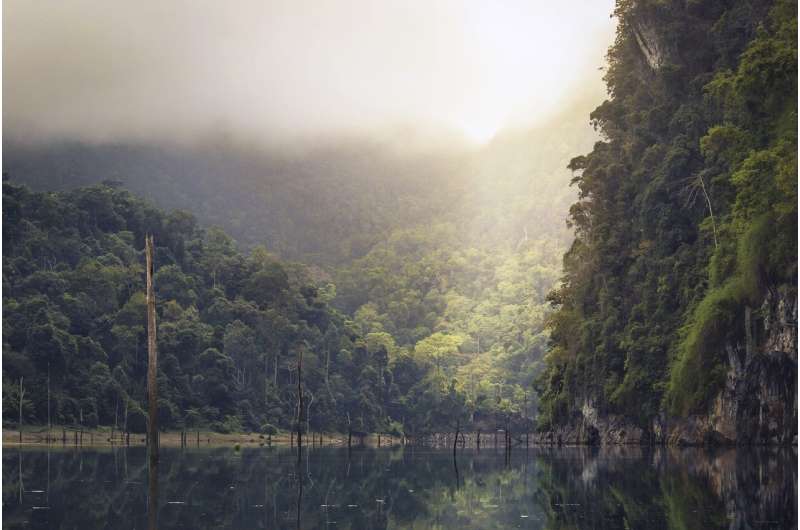Shedding light on how much carbon tropical forests can absorb

Tropical forest ecosystems are an important part of the global carbon cycle as they take up and store large amounts of CO2. It is, however, uncertain how much this ability differs between forests with high versus low species richness. New IIASA research sheds light on this question, aiming to enhance predictions of tropical ecosystem strength as global carbon sinks.
The authors of the new study published in Scientific Reports investigated how many species are needed for tropical ecosystem functioning and associated ecosystem services, including carbon sequestration, to project future changes in the climate that affect ecosystem carbon storage and thus might trigger further climatic change through increased greenhouse gas emissions. It is important to construct realistic scenarios of how tropical ecosystems function to improve current conservation and management strategies.
"We wanted to find out how much detail we need to know in order to make valid assumptions in terms of the strength of tropical carbon sinks—in other words, how much carbon is actually sequestered by tropical vegetation? In addition, we wanted to know whether biotic factors, differences between plant species, are responsible for capturing more or less carbon from the atmosphere, or if differences are due to abiotic, or local environmental factors like soil properties that also influence carbon sink strength in tropical ecosystems," explains study lead author Florian Hofhansl, a postdoc researcher with the IIASA Ecosystems Services and Management, and Evolution and Ecology Programs.
According to the researchers, it is generally assumed that more diverse communities capture available resources more efficiently due to niche complementarity and preferences of certain species to specific conditions. The results show that in fact, abiotic and biotic factors interact with one another to determine how much carbon can be stored by the ecosystem based on the availability of other resources like water and nutrients. This indicates that multiple and interrelated factors would need to be accounted for to arrive at plausible projections of future ecosystem carbon sink strength.
An analysis based on statistical path modeling revealed that apart from climatic factors such as temperature and rainfall, factors like soil texture and chemistry are important controls when it comes to tropical plant community composition, as they affect the resource availability of water and nutrients.
In this regard, the study specifically looked at differences between trees, palms, and lianas (long-stemmed, woody vines that use trees and other plants to climb up to the canopy). Each of these groups differ in terms of the amount of carbon they are able to store due to differences in their ecological strategy. Lianas are, for instance, relatively fast-growing and try to reach the canopy to get to the sunlight, but do not store as much carbon as a tree stem to reach the same height in the canopy.
Palms mostly stay in the understory. The analysis further showed that palms were more abundant on soils with high bulk density and low soil phosphorus availability, while certain tree species were found on relatively less dense soils with high soil water availability, leading to differences in plant community composition across the landscape. In addition, sites with fewer resources contained less diverse plant communities than those with ample soil water and nutrient supply.
Traditional large-scale projections of global change effects on tropical forests, however, typically ignore the underlying factors triggering differences in plant community composition, and as a consequence, most of the currently applied approaches fail to represent crucial ecosystem processes such as vegetation carbon storage. This is mainly because remote sensing techniques typically integrate over large spatial areas, thus averaging out local landscape diversity, while vegetation models usually ignore the variable response of different plant communities to climatic factors. The authors say that their study results could be used to improve current vegetation models, thus allowing scientists to refine projections of tropical forest ecosystem functioning under future climate change scenarios.
"We can only arrive at the right conclusions and provide future projections of how much carbon can be stored if we understand the complexity within ecological systems and what this means for atmospheric feedbacks, such as emissions of greenhouse gases further increasing global warming," says Hofhansl. "Our analyses highlighted that it is important to channel knowledge form multiple scientific disciplines, such as botany (identifying species), plant ecology (identifying functional strategies), and geology (identifying differences in soil types). All of this will determine how much carbon is sequestered by the vegetation and how much of it will remain in the atmosphere, thus further heating up the climate system," he concludes.
More information: Hofhansl F, Chacón-Madrigal E, Fuchslueger L, Jenking D, Morera A, Plutzar C, Silla F, Andersen K, et al. (2020). Climatic and edaphic controls over tropical forest diversity and vegetation carbon storage. Scientific Reports DOI: 10.1038/s41598-020-61868-5
Journal information: Scientific Reports




















